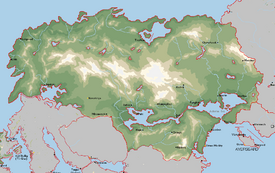Kolodoria
Socialist Republic of Kolodoria Kolodorija | |
|---|---|
|
Flag | |
| Motto: Mēs neatlaidīgi izturēsimies. We will persevere. | |
 | |
| Capital | Salhar |
| Largest city | Strana Mechty |
| Official languages | Kolodorian |
| Demonym(s) | Kolodorian |
| Government | Unitary Marxist-Leninist one-party socialist republic |
• President | Carmen Miranda's Ghost |
| Legislature | Federal Council |
| High Council | |
| Federal Assembly | |
| Area | |
• Total | 3,626,701 km2 (1,400,277 sq mi) |
| Population | |
• 2019 census | 166,170,540 |
• Density | 45.81/km2 (118.6/sq mi) |
| GDP (PPP) | estimate |
• Total | $1,857,339,400,000 |
• Per capita | $11,177.31 |
| GDP (nominal) | estimate |
• Total | $1,652,840,220,000 |
• Per capita | $9,946.65 |
| Currency | Credit |
| Driving side | right |
Kolodoria, officially the Socialist Republic of Kolodoria, formerly known by its Letnian name Kolodoriya, is a soverign state in northern Vinya. It is bordered by Letnia to the east, Cherniyan to the south-east,Tír Tairngire, Vyzhva, and Tír an Crainn to the south. Its capital is Salhar, while the largest city is Strana Mechty located on the Tukayyid Coast. Over 65% of its territory is covered by taiga and tundra. Its major economic sectors are manufacturing and exporting of natural resources. Until the 19th century Kolodoria was governed by numerous kingdoms and nations until it was unified in 1844 into the Confederation of Kolodoria.
Kolodoria steadily modernized and industrialized between the late 19th and 20th centuries, although by the 1930s was still a heavily rural country composed of numerous constituent kingdoms, principalities and republics. Kolodoria's growing role in regional affairs, in addition to its numerous territorial disputes with neighboring Letnia and Cherniya led to the outbreak of the Northern War in 1940 when Letnia invaded eastern Kolodoria. The four yearlong conflict eventually ended in Kolodorian defeat, and the subsequent economic fallout severely strained Kolodoria's economic and social fabric.
The civil unrest in Kolodoria eventually blossomed into the communist instigated Kolodorian Revolution in 1954, resulting in the dissolution of the Confederation and the establishment of the Socialist Republic a one-party Marxist-Leninist State rule by the Kolodorian Communist Party. Led by General Secretary Aleksis Kraulis, the de facto dictator of the Socialist Republic, Kolodoria rapidly modernized under nationalized petroleum and mining industries which saw strong GDP growth between the 1950s-1970s. In 1975 Kolodoria invaded Tir Tangerine to reclaim the disputed Zavijava region resulting in the outbreak of the Vinyan War which lasted until 1980. Six years later Kolodoria and Vyzhva entered into a brief eight month border conflict which resulted in minor Kolodorian gains. In 1996 Kolodoria's long standing disputes with neighboring Cherniya resulted in the outbreak of the Cherniyan War. Unlike its two previous conflicts Kolodoria saw now gains and was repulsed in 2000 by combined Letnian and Cherniyan forces; the death of Kraulis in 2000 preceded the peace process.
Fallout from the Cherniyan War, both economic and political isolation, as well as the death of Kraulis led to a power struggle within Kolodoria's Communist Party, culminating in the passing of several liberalization reforms that privatized many sectors of the Kolodorian economy and saw a return to positive GDP growth. This period of liberalization, combined with the Polvokian Civil War and market reforms in Menghe and Maverica is generally regarded to mark the end of hard line communism in Septentrion, though Koldoria remains officially a one party Marxist-Leninist State.
Kolodoria remains a communist state in many areas, maintaining nationalized oil, steel, natural gas, and defense industries, as well as officially barring any other political parties outside the Kolodorian Communist Party. Media outlets outside party control are limited and heavily censored, and many sectors of the economy and society remain under state control. Nevertheless Kolodoria has endeavored in recent years to improve relations with it's neighbors, especially members of the Vinyan Defense Union. Kolodoria cooperated with the VDU and other foreign powers in the 2019 Invasion of Vyzhva to depose the Zayetist regime.
